Mittlerer Zugkraftwagen 8t, Sd.Kfz. 7
 Germany (1934-45) - Utility Heavy Half Track - 12,187 built
Germany (1934-45) - Utility Heavy Half Track - 12,187 built
Design development 1934-38
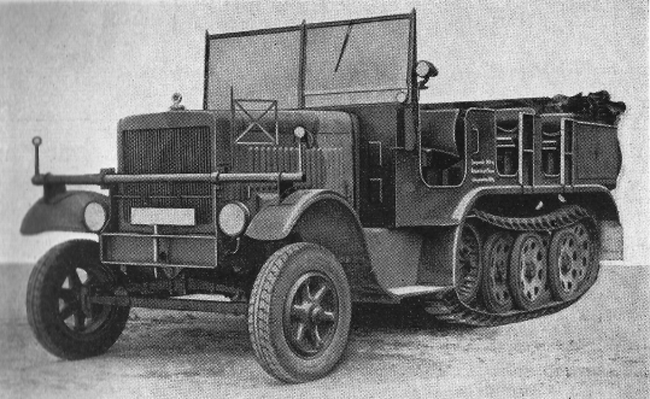 Krauss Maffei MS (m5) type tractor, 1928-1930
Krauss Maffei MS (m5) type tractor, 1928-1930
The Mittlerer Zugkraftwagen 8t (Sd.Kfz.7) was a medium halftrack/tractor/prime mover of the German Army. It was designed by Krauss-Maffei AG of Muenchen-Allach and was produced by Krauss-Maffei of Munich, Borgward of Bremen, Buessing-NAG of Berlin, Daimler-Benz of Berlin, and later by Saurer Werke AG of Vienna and Breda in Italy. Development started as early as 1933 and went on until 1939 for full-scale production until March 1945, with 12,187 produced, peaking in 1944 to 3,352 at a whooping unit cost of 36,000 RM. Sd.Kfz.7 was used on all fronts with all panzerdivisions, with still 3,602 in service by March 1945.
 Detail of the under axle forward, chassis
Detail of the under axle forward, chassis
Krauss-Maffei AG started working by 1928 on the experimental MS (m5) type tractor (photo above). The next M7 was based on the Waffenamt 1933 official specification and grew in size and power. This became the prototype of the future Sd.Kfz.7. The First 8t production model appeared in 1934 as the Krauss-Maffei m8 (photo below). It was longer than m7 and powered by 6 cylinder Maybach HL 52 engine. Similar vehicles were produced by Buessing-NAG – BN m8 and Daimler-Benz – DB m8. KM m8 was followed by an improved version in 1936 – KM m9. New and improved model was powered by Maybach HL 57 engine.
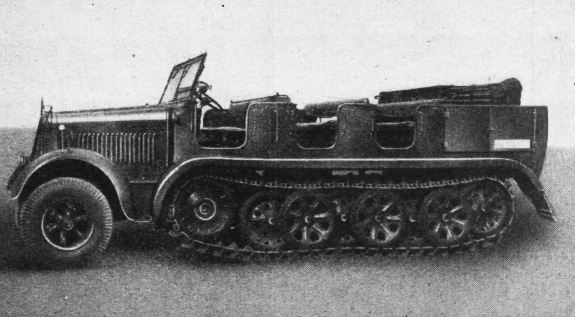
Krauss-Maffei made 127 KM9 in 1936, followed by the almost identical KM m10 with a 140hp Maybach HL 62 engine. It was also assigned for production by Hansa-Lloyd-Goliath AG of Bremen (Borgward) and denominated HL m10, with 222 made. In 1937, the final KM m11 entered production, standardized by the waffenamt as the "Mittlerer Zugkraftwagen 8t (Sd.Kfz.7)", the "middle prime mover special vehicle 8 tons serie 7". Borgward made a copy called the HL m11. In 1943, the Maybach HL 62 engine was replaced by the Maybach HL 64 and it became the main prime mover for the dreaded 88mm Flak guns, but also standard 105mm sK 18 heavy field artillery, 150mm sFH 18 howitzers and a few others.
Design
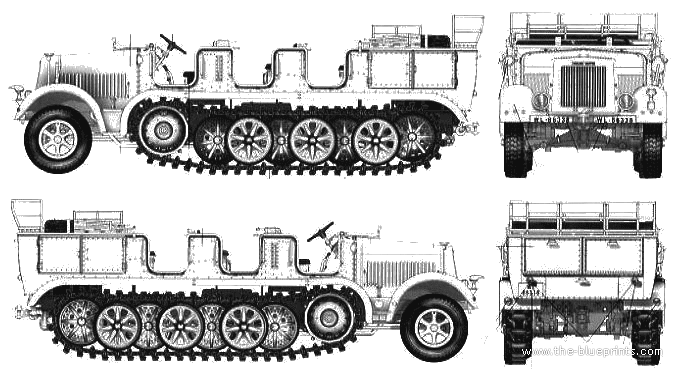 Plans on the blueprints.com
Plans on the blueprints.com
As standard tractor/prime mover Sd.Kfz.7 (no slash digit), it had three seats forward, three alongside the driver (crammed), and seating bunks in two more rows aft of four "seats" each for 12 men in all (3x4) including the driver, while equipment and ammunition/supplies were stored in the rear compartment, which had a usable "deck" above for storage (often of the tarpaulin and arches), and two-piece doors either side. The vehicle could tow up to 8,000kg (17,600 lbs) as max payload. It was also fitted with a winch of 3,450kg (7,600 lbs) capacity, used for self(unditching or of other vehicles.
The vehicle overall weight was 9,700kg (21,340 lbs). It measured 6.85m (22 feet, 8 inches) long, 2.35m (7 feet, 8 inches) wide, 2.60m (8 feet, 5 inches) high with tarpaulin.
It was powered by a 6-cylinder Maybach gasoline engine, served bt a five-speed gearbox transmission, four forward and one reverse. The clutch arrangement and planetary system enable plenty of torque and the vehicle was able to accelerate from 3.5km/h to 50km/h in a short time (3mph to 31mph), for a top speed on flat of 50km/h (31mph). Range was 250km (156 miles) on road down to 120km (75 miles) cross-country despite a fuel capacity of 215 liters (57 US gallons). Fuel consumption indeed was no less than 80 liters for 100km, about 3 miles per gallon on flat and a whooping 160 liters for 100km (1.5 miles per gallon) cross-country. The vehicle was unarmed, but personal weapons of the 12 men carried.
Main variants in details
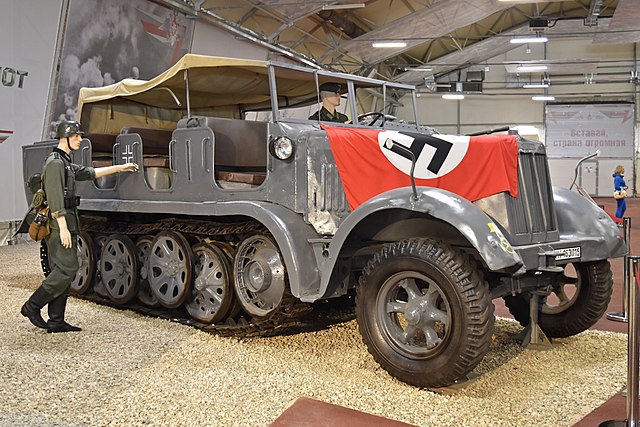 Sd.Kfz.7 at the Kubinka Museum
Sd.Kfz.7 at the Kubinka Museum
- Sd.Kfz.7/1 – 2cm Flakvierling 38 auf Selbstfahrlafette Sd.Kfz.7/1
- Sd.Kfz.7/2 – 3.7cm Flak 36/37/43 auf Selbstfahrlafette Sd.Kfz.7/2.
- Sd.Kfz.7/3 – Feuerleitpanzerfahrzeug für V-2 Raketen auf m. Zgkw. 8t.
- Sd.Kfz.7/5 – Artemis – 7.62cm(r) Pak auf Zgkw 8t*.
- Sd.Kfz.7/6 – Flakmesstruppkraftwagen – Sd.Kfz.7 with AA range finder.
- Sd.Kfz.7/8 – Mittlerer Zugkraftwagen 8t mit Pionieraufbau
- Sd.Kfz.7/9 – Mittlerer Zugkraftwagen 8t mit Artillerie aufbau
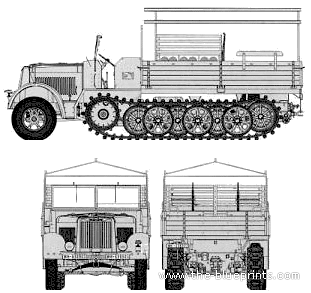
Another variant allegedly being the Sd.Kfz.3 on the blueprints.com, that might be the /8 or /9.
Sd.Kfz. 7/1
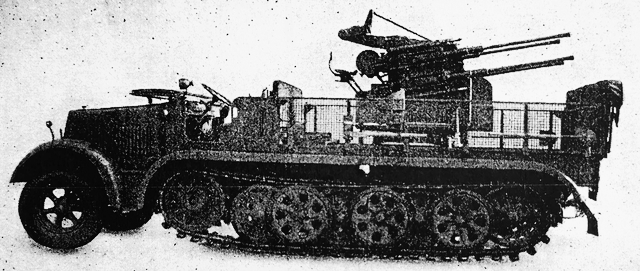
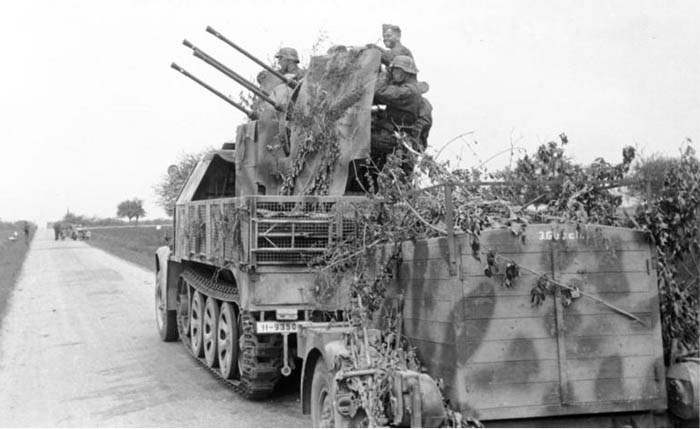
The 2cm Flakvierling 38 auf Selbstfahrlafette Sd.Kfz.7/1 became the default choice to operate the 20 mm quad AA mount (Flakvierling 38). Far more (750) were built than the Panzer IV Wirbelwind using the same mount. Of course the base vehicle was unarmoured, apart the gun shield, and the "gepanzerte" sub-variant was built after August 1943, with an up-armored cabin with 8 mm steel plating, official designation changed to "Selbstfahrlafette mitgepanzertem Fahrerhaus auf m.Zgkw.8t (Sd.Kfz.7/1) mit 2cm Flakvierling 38"; which production numbers remains ellusive. A full article has been done on
Tank Encyclopedia.
Sd.Kfz. 7/2

The second FLAK variant. The sturdy chassis was put to good use when mounting the 3.7 cm FlaK 36 anti-aircraft gun, and from1944, the 3.7 cm FlaK 43. Same principle, it was installed on the rear flatbed, with the same folding step barriers and spare ammunition bins. The vehicle existed in two versions, basic, and with the armored cab ("gepanzerte") seen on the Sd.KFz 7/1. About 1000 were produced by the end of January 1945 of all versions. The gun mount was high enough to enable fire forward at 0°, using the penetrating qualities of rapid fire 37 mm rounds to good effect on allied armour as well. Unlike the 7/1 Flakvierling, the 37 mm stayed potent against later war allied planes.
Sd.Kfz. 7/5 Artemis*
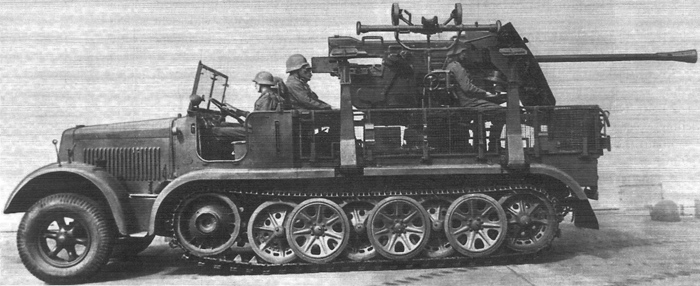
This is a known fake. It was supposed to be a 7.62cm PaK36(r) mounted on the flatbed of a regular 7/1, which was not mentioned once in the "Encyclopedia Of German Tanks Of World War Two" by Peter Chamberlain and Hilary Doyle. There was an imaginative kit showing the gun encased in a fully armored rear compartment, so having no traverse, but by the vehicle itself. No photo exists of it anywhere. There was however another interesting prototpoe equipped with a 5 cm FLAK 41: The 5 cm Flak 41 auf Sd.Kfz.7 or m.Zgkw. 8t mit 5 cm Flak 41 (Sf). At the turn of 1940/41, a single prototype was created. Like the 3.7 cm FLAK, it was shieled and mounted on the flatbed, with essentuially the same folding panels to be used as walking platform around plus attachment points for the massive ammunition clips. The FLAK gun was producd to circa 60 but production was stopped due to cost issues and standardization by Albet Speer, and so did the conversion program. According to the post-war memoirs of Obl.t. Ralf Maus (referent Entwicklungsforderungen leichte und mittlere Flak, L.In.4) the prototype was shown to Adolf Hitler, but his decision that it was a too heavy and material-intensive to be continued.
SRC
Sd.Kfz. 7/6 Flakmesstruppkraftwagen
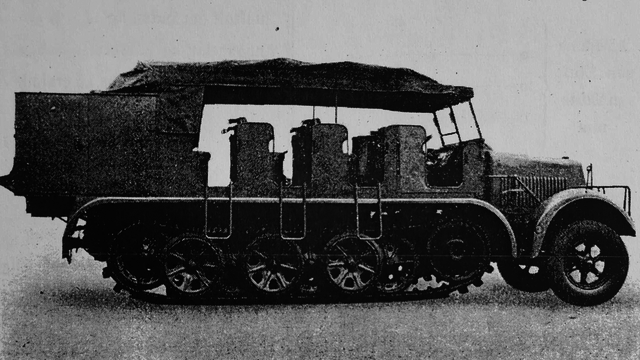
A less current variant, the Flakmesstruppwagen (Sd. Kfz. 7/6) was a rare sight. It was a medium A.A. "survey party vehicle" which often towed the command device 36 (Kommandogerät 36). It was recoignisable to its squarish, bulky and tall storage at the rear. They also were recognized to the cable drums on their fenders. But in some cases, no holders for cable reels are visible but there was a cable holder for the spare wheel on the left side. Production and dates unknown.
Sd.Kfz. 7/9 Feuerleitpanzerfahrzeug
 Feuerleitpanzerfahrzeug transported by rail from Penneünde to Stuttgart
Feuerleitpanzerfahrzeug transported by rail from Penneünde to Stuttgart
The Feuerleitpanzerfahrzeug für V-2 Raketen auf m. Zgkw. 8t is another interesting and rare derivative. It was basically a command vehicle, armoured (rear cabin only) with observer dome. They were produced in small quantities for V2 ballistic missile units, as dedicated, protected fire control vehicles in 1944. In total 49 were made from March to November 1944. They were also primary towing vehicles for the V2 launching platform trailer.
Breda 61
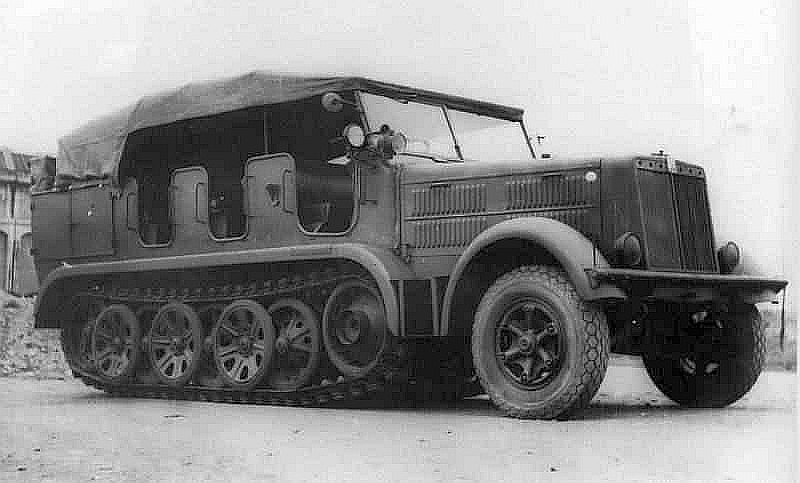
The Breda 61 was a German SdKfz 7 manufactured in Italy under licence, with 250 made total. The main difference was its right-hand drive unlike the German version, otherwise, it was virtually identical. A dedicated article will be made on it there.
The Sd.Kfz.7 in combat
 German vehicle in Italy, towing a 15 cm Feldhaubitze 40
German vehicle in Italy, towing a 15 cm Feldhaubitze 40
The base vehicle became a common prime mover for german artillery in WW2. Unlike wheeled vehicle, they were only made to soldier on the eastern front, poor in roads and often clogged with mud or deep snow. The half-tracks possessed advantages on this terrain over wheeled tractors, despite they were difficult to maintain, often suffer track breakages, and on good conditions were much slower. The Sd.Kfz.7 was used and produced until May 1945 with over 12,000 delivered. These big vehicles were filmed at the 1940 Paris victory parade and was prominent in many German wartime propaganda footage, to fuel the idea of a fully mechanized Blitzkrieg. But as the rest of this type, production was costly aand labor-intensive, never reaching the division they were supposed to equip. The were organically assigned on paper on all artillery elements of PanzerDivisions and attached mechanized infantry units, the Panzergrenadier. For second echelon unit, guns were horse drawn.

The Sd.Kfz. 7 was at eas on sand and thus, was extensive used in Rommel's Dueutsch Afrika Korps, where it became the prime mover for the previous 88 mm FLAK. Troop columns on this front often include at least two half tracks, placed forward to create paths in the sand to follow by wheeled trucks. The base vehicle became also indispendible on the Ostfront, between the rasputitsa and winter. They were never enough. By 1944 these precious vehicles were turned into armor systems as seen above, especially to protect armored columns against allied aviation from 1943, with 2cm and 3.7 cm FLAK self-propelled variants. But apart those seen, they were also field conversions, to carry for example a single 2 cm anti-aircraft gun, and a 5 cm FlaK 41 was tried in 1943 but rejected, and there was the V-2 ballistic missile fire control vehicle which appeared from 1944. They in addition often towed the Meillerwagen trailers to erect the missile atop the launchstands/flame deflectors. Mobility enabled them dispersing for surprise launches and avoid Allied air attacks. They basically wrote the book about TEL trucks in use today.
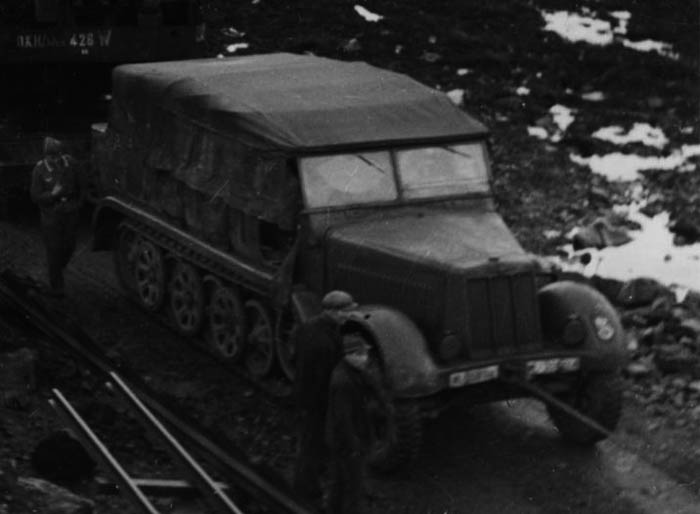 With full canvas and winter platic/cloth windows in Norway, 1942
With full canvas and winter platic/cloth windows in Norway, 1942
Between allied bombings of the facilities that made the vehicles and all sorts of shortage, the production started to fell, or was diverted to the variants seen above (2100+), meaning less were even available at any type for Panzerdivisions. The Italian Army started to make use of the vehicle, notably producing it via Breda, soldiering in Northern Italy until May 1945. The heavy vehicles had a real all-terrain mobility that stunned the British Armies in North Africa, so eny captured was to be a precious object of study. A British improved copy was even made by Bedford Motors (subsidiary of Vauxhall) as the Bedford Tractor (BT) or "Traclat" (Tracked Light Artillery Tractor), for towing the 17 pounder, 25 pounder and Bofors 40 mm while usung if possible existing parts and production capacity of the company.
 Vauxhall B.T. ¾-track Traclat Prototype. Credit: Vauxpedia
Vauxhall B.T. ¾-track Traclat Prototype. Credit: Vauxpedia
It was ordered in 1943 by the the Ministry of Supply as a "
three-quarter tracked vehicle" with same schafellaufwerke track system, rear suspension, from the study of several captured half-tracks left over in Tunisia and shipped back to Britain from Libya. Morris had them in long trials and evaluation and six prototypes were made in 1944, the war ending before production could start. The Traclat was even seen as superior to the original, with more accessible ammunition lockers, power-assisted steering. By early 1945 Vauxhall sent a "final" prototype for more testing at the Fighting Vehicle Proving Establishment (FVPE) and it excelled in all conditions, but it was just too late. In July 1946 it was further tested towing a 25-pounder gun and compared favourable against a Crusader artillery tractor, Alecto self-propelled gun, yet still it bogged down in mud. Without any postwar requirement, production failed again to materialize.
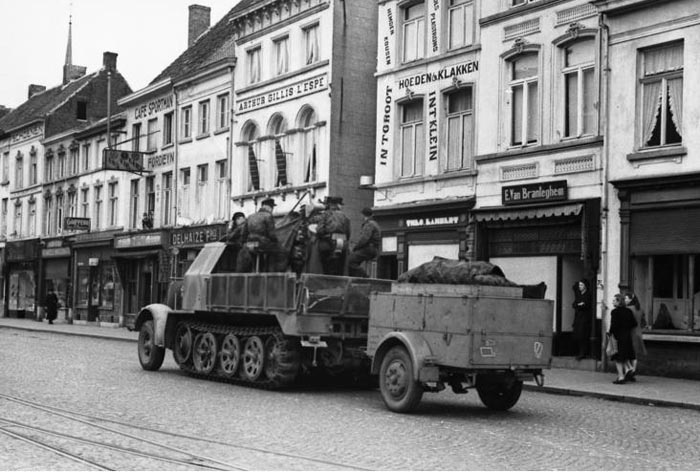 Sd.Kfz.7/1 in Belgium, 1944
Sd.Kfz.7/1 in Belgium, 1944
The Czechoslovak Army captured and used them for until after the war. Apart Italy, no other axis member used the vehicle, at least officially. The Bulgarian Army operated also a few between 1941 and 1944. They were Borgward HL m11 and Krauss-Maffei KM m11 models, much older and phased out from the Wehmacht. Yugoslav partisans also captured some, put to good use. 32 Sd.Kfz. 7 of the early 1938 batch were sold to the Brazilian Army in 1939, but with the war going on, only 5 were delivered by late 1941...
 In an armoured colum, Italy, summer 1944.
In an armoured colum, Italy, summer 1944.
Links about the Sd.Kfz.11
The Sd.Kfz.7/1 on Tank Encyclopedia
The Sd.Kfz.7 on Wikipedia
Surviving SdKfz 7 - The schadocks pdf
Commons
ostfront.forumpro.fr
worldwarphotos.info
wiki CC
achtungpanzer.com
kfzderwehrmacht.de sd_kfz__7_m__zgkw__8t
Walkaround
2iemeguerre.ca
weaponsystems.net
7/2 On kfzderwehrmacht.de
7/1 On kfzderwehrmacht.de
The Sd.Kfz.7 today on the field
On scalemates (all typ 7)
Hanomag Sd.Kfz.7 specifications |
| Dimensions | 6.85 m (22 ft 6 in) x 2.35 m (7 ft 9 in) x 2.62 m (8 ft 7 in) |
| Total weight, battle ready | 11,53 tons (lb) |
| Crew | 12 (driver, +11 personal) |
| Propulsion | Maybach HL62 TUK, six-cylinder petrol 135 PS, (133 hp, 99 kW) 12.1 hp/tonne |
| Top speed | 50 km/h (31 mph) road |
| Payload | 1,800 kg |
| Transmission | 7 + 3 speed Maybach Variorex SRG 102128H |
| Suspension | Torsion Bars |
| Maximum range (on/off road) | 215 liters, 250/120 km (160/75 mi) |
| Armament | None, see notes |
| Armor | 6 mm (0.2 in) |
| Production | Various, 1935–1945: 12,187 - 36,000 Reichmark |